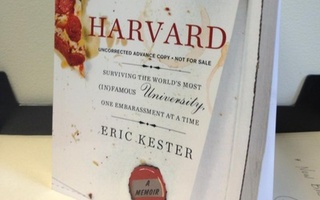“Just be friendly. Friendly and aloof,” Penelope O’Shaunessy’s mother advises her as they drive from her hometown in Connecticut to Cambridge. Though Penelope concedes, “OK,” she notes skeptically, “A reconciliation of opposites.”
Penelope is the hapless protagonist of a new novel, “Penelope” by Rebecca M. Harrington ’08, a former Crimson arts editor. The novel follows its gawky namesake through her turbulent freshman year at Harvard.
Members of the Class of 2016 undoubtedly received similarly conflicting advice from their parents only a week or two ago, the most common: study hard and have fun! And all students probably share similar fears about social skills.
If a freshman does not share these basic woes, the student probably a) already knows the particular social stratum into which he/she would like to neatly insert him/herself or b) does not want friends. These opposing categories also tidily define Penelope’s two archetypal roommates. One roommate, Emma, is a melodramatic and manipulative social-climber from New York City who cries over “Pudding stuff.” Her other roommate, Lan from Palo Alto, is a terse genius who socializes mainly with her cat, Raymond, Penelope’s fourth roommate in their Pennypacker triple.
Lodged between her two extreme roommates, Penelope, shiftless and clueless, flits around campus looking for friends and romance. Ultimately, the overly amenable and passive Penelope does not attain the social life she desires. Her problem seems to lie in her bizarre social conduct, described in a telling moment between her and the director of a production of “Caligula.”
The director critiques Penelope’s maneuvering of a marionette during rehearsal, commenting, “It just looks too much like a marionette, Penelope. It’s incredibly stiff. I need it to mimic the fluidities of human motion as much as possible while, at the same time, ironically referencing the artificiality of theatre itself.” The director’s absurd demand seems to manifest Penelope’s central struggle in the novel: how to navigate conflicting and puzzling situations at Harvard. Moreover, the director’s comment reflects the way Harrington herself strays from traditional campus novels that depict college as a transformative experience. In “Penelope,” the absurdity of college experience can be conveyed only through parody.
STRANGELY BLANK
Neither Penelope the character nor “Penelope” the novel have any significant narrative thrust. The plot can be essentially summed up in list form: Penelope meets her roommates; hangs out in her entryway; takes a silly-sounding General Education class; goes to a party at a club named “The S---,” kisses a drunk boy; kisses an awkward boy, kisses an “international playboy;” comps the Harvard Advocate; gets suckered into an extracurricular she hates; gets in a fight with her roommate; and eventually learns that everyone is pretending to be someone they’re not.
Most sophomores could check off at least half if not all the items on this list. But even if her experiences are typical, Penelope’s perspective is unique. Her observations are incisive and at times laugh-out-loud funny. One of her quips: “Homework was like a North Star that everyone turned to.” Her eccentric ideas of decorum—including if you say “hello,” “cool,” and “awesome,” everyone will like you—are endearing, yet she remains a strangely blank slate and never outgrows her awkwardness or social ineptitude.
Despite its lack of traditionally vital elements of storytelling, the novel works. There’s not much plot and the characters are not developed but it’s not the traditional coming-of-age story that would require those elements. The novel succeeds by virtue of its amusing and often searing profile of a dysfunctional Harvard that runs on elaborately bullshitted papers and even more elaborately constructed personae. Penelope manages to bump into all manner of Harvard caricatures, allowing Harrington’s satirical voice to shine.
NYC WHAC-A-MOLE
If the book’s cover—an image of two hands about to dig into a Veritaffle—is a gentle hint at the mockery to come, the first page is a slap in the face. The book opens with the correspondence between Penelope and her roommates. The first Facebook message, from Emma, sketches a gag-worthy portrait of the absurdly ambitious and unthinkably obnoxious girl from New York City. “I can’t believe I’m going to be missing out on New York pizza and dry cleaning for a whole four years!” she writes.
My freshman year often felt like a never-ending game of Whac-A-Mole, in which I whacked the New York private school stereotype instead of moles. The dry cleaning comment certainly elevated my blood pressure, but it was the following line in Emma’s note that made me twitch. In this emetic message, Emma mentions that she attended the Spence School—the very school I had attended for 13 years. While I knew many Emmas in my time at Spence, Harrington’s use of the proper noun seemed intrusive and impertinent.
Harrington’s trespassing continued when Penelope wanders into the comp for the fiction board of the Advocate, which Harrington depicts as a modish bastion of literary pretension. Besides the Advocate being the oldest continually published college literary magazine in America, it is also the magazine of which I recently became an enthusiastic member of both the poetry and executive boards.
The fiction editor of the Advocate, Patrick W. Lauppe ’13, also an arts editor of the Crimson, thinks Harrington took “easy shots” with her portrayal of the magazine. “‘Penelope’ is a tremendous achievement by a recent Harvard grad, and I really respect her for it,” Lauppe says. “And though I do recognize definite accuracies, which are pretty funny, I feel like it’s almost a freak show.”
Read more in Arts
Gersht’s ‘History’ of Violence in MFA ShowRecommended Articles
-
PenelopeIn the whimsical movie “Penelope,” title character Penelope Wilhern, played by Christina Ricci, seems to have it all. As the
-
History of Science Rethinks Sophomore TutorialThe History of Science department unveiled a revamped sophomore tutorial this semester featuring virtual interviews, student-driven lectures, and a chance for students to engage in independent research.
-
 Which Books About Harvard Are Worth Reading?
Which Books About Harvard Are Worth Reading? -
"Penelope" is an Exciting OdysseyDirected by Jacob A. Brandt ’14, "Penelope", which runs from April 25 to May 3 on the Loeb Mainstage, gleefully collides the sublime with the ridiculous, transporting a mainstay of world literature to a banal, seedy modern-day setting. In the able hands of its four main actors, the Harvard-Radcliffe Dramatic Club’s production pulls off the play’s comic elements without passing over the sense of unease at the play’s heart.
-
 Athlete of the Week: Harrington Makes 22 Saves in Big Weekend for Women's Water Polo
Athlete of the Week: Harrington Makes 22 Saves in Big Weekend for Women's Water Polo














